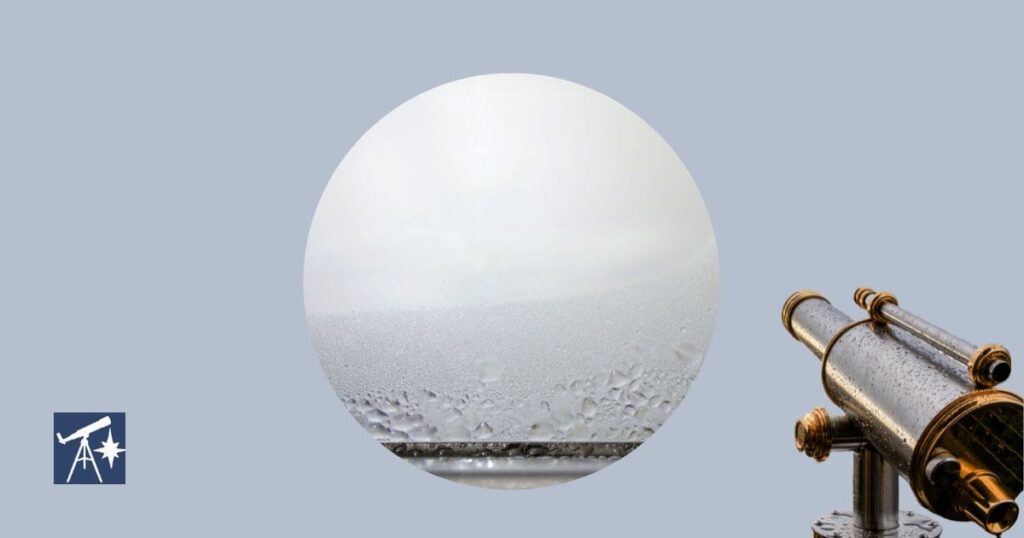You’re thinking about having your telescope set up for a few hours or overnight outside. Is it that you’re worried and wondering: Can a telescope get wet during that time? Here’s what I discovered about getting your telescope wet and what to do about it.

How Your Telescope Got Wet
You probably know that moisture is your telescope’s worst enemy – right? It can ruin your optics, corrode your mount, and damage your electronics.
But it depends on how wet and how long it’s been left that way.
So how does your telescope get wet in the first place? It could’ve got wet from poor storage. But let’s explore some common scenarios.
Overnight Rain Wet My Telescope
You set up your telescope in your backyard, hoping to catch a glimpse of the stars. The skies are clear, and you’re excited to start observing.
But in the middle of the night, you hear the sound of raindrops. You rush to cover your telescope, but it’s too late. The damage is done.
Left the Telescope Out and It Snowed or Iced
You had a great night observing, but you were too tired to pack up your telescope. You left it outside, thinking it would be fine.
The next morning, you wake up to a light layer of snow or ice. Your telescope is covered in white.
Dew on my telescope
You’re outside on a clear night to view the stars with your telescope. If there’s a drop in air temperature, moisture in the air can quickly condense into small droplets. You might start to notice your clothes feeling damp or the surfaces are wet.
This happens as dew droplets accumulate on items. This includes your telescope. Dew forms when water vapor condenses out of the air.
How to fix Dew getting on my telescope
Wiping the dew off optical surfaces is futile. What you need is a way to prevent dew from affecting your telescope.
Options for this include a dew shield (or cap). You can choose a cap to suit your telescope. This one illustrated is designed for a Schmidt Cassegrain.

Dew Shield for a SCT
available at Amazon (affiliate link)
Some caps have a heater included. These blow air to keep the lens dry.
You might also get condensation or dew on bringing your telescope from the cold outdoors into the warm indoors.
Same deal, a temperature change will do it. In this case, let your telescope ‘breathe’ for a time indoors before you cover it up or put it away for storing. This should allow the condensation to dissipate.
A DIY dew cap
You can make a DIY dew cap for your telescope using everyday materials.
What you need:
- An oversized can, like a catering-sized coffee container
- Craft knife
- Scissors
- Metal file
- Fabric tape measure
- Black duct tape or electrical tape
- A marker pen
Thanks to Sky at Night Magazine for this idea.
- Find a coffee container or similar shaped container with a diameter that matches your telescope
- Cut the container to the desired length and shape it into a tube
- Smooth edges using the metal file
- Use the tape to secure the edges and create a seam
- Add a felt lining to the inside of the cap to prevent scratches on the telescope lens
To prevent your telescope from getting wet
- Always check the weather forecast before setting up your telescope
- If there’s a chance of rain, snow, or similar moist weather, don’t take any chances
- Either wait for a clear night or set up your telescope indoors
- Use a shield or cover to protect your telescope
- Store it away properly after use – I wrote an article covering critical points about this
To defog a lens
With the temperature change, your telescope lens will fog up. To de-fog it, the most effective method is to control its temperature.
To do this, bring the telescope indoors to rest in ambient conditions. Or you can sit with it in your car for a while with the air con running.
Avoid wiping the lens with any old cloth. To clean or dry the lens, use a proper lens cleaning cloth instead of a towel or the corner of your shirt. You’ll find out more about lens cleaning in this article I wrote.
How to dry a wet telescope
When it comes to wiping dry the telescope, a soft cloth is fine for the outside of the tube. But be careful with the lenses.
Avoid wiping the lens with any old cloth. If there are any tiny spots of dust on it, wiping the lens could scratch and do permanent damage to the surface coatings.
The scratches might be fine but looking through the scope they will be large enough to ruin your viewing experience.
What you can do is point the telescope vertically and let it drip dry indoors. It depends on how wet your instrument is.
Don’t attempt to dismantle your telescope to dry the inside. Leave it and see how well it dries. You don’t want to risk opening to more moisture.
FAQ
Why Is There Condensation in My Telescope?
Condensation occurs when warm air meets a cold surface. If your telescope has been stored in a warm room and you take it outside on a cold night, condensation (like dew) will form on the optics. To prevent this, let your telescope cool down to the outside temperature before observing.

